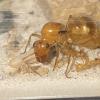Very quick update, but when I picked up my new Acromyrmex, I also picked up the following, all in test tubes:
3 founding CA02 queens.
1 founding C. "maritimus or anthrax" queen (I'll call it C. marianthrax).
1 founding C. vicinus(?)
1 C. vicinus with a crushed gaster who was able to found successfully anyway (I call her "Crushy").
1 C. cola colony.
1 established CA02 colony (now moved to a mini-hearth but I should've taken the nest tube out so she can fit).
---- Existing previous non-fraggle Camponotus colonies:
2 thriving C. vicinus colonies in mini-hearths (so sad that "Lucky" queen died after getting boosted)
1 C. cola colony outgrowing its tube-in-tub.
3 C. CA02 colonies, each in its own mini-hearth. One (the one with a bad front leg) is doing well with pupae. The other two are down to elderly workers and a few eggs.
Edited by OhNoNotAgain, May 24 2023 - 1:52 PM.
















